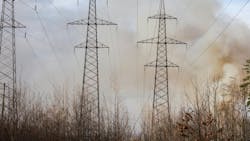Trump Executive Order Targets Wildfire Prevention, Calls for Utility Action on Grid-Related Risks
Electric utilities are being urged to take a more proactive role in wildfire mitigation under a sweeping new Executive Order signed by President Donald J. Trump aimed at modernizing and streamlining the nation’s wildfire prevention and response strategies.
The order, titled Strengthening Wildfire Prevention and Response, directs federal agencies—including the Departments of Interior, Agriculture, and Defense—to consolidate fire programs, promote technology adoption, and reduce regulatory barriers to land management practices. For utilities, the directive specifically calls for action to "minimize wildfire ignition risks from the bulk-power system."
The Edison Electric Institute (EEI) interim President and CEO Pat Vincent-Collawn issued the following statement in response to President Trump’s Executive Order on wildfire prevention and response.
“EEI and our member electric companies commend President Trump for calling for a streamlined, common-sense federal approach to help prevent wildfires before they happen and to protect affected communities across the United States from long-term costs.
“Wildfires are a societal problem that require societal-level solutions. Enhancing coordination across the federal agencies is a positive step, and we look forward to supporting these efforts to develop a comprehensive national approach that emphasizes community protection, wildfire prevention, responsible investment, and rapid recovery. Congress also can support these efforts by sending the Fix Our Forests Act to President’s Trump desk.”
Implications for the Power Sector
In recent years, electric transmission and distribution infrastructure have come under increased scrutiny as ignition sources during dry, high-wind conditions—especially in Western states. This order reinforces the need for utilities to invest in advanced grid monitoring, vegetation management, and system hardening to reduce fire risk.
The order instructs federal agencies to:
-
Revise permitting rules to accelerate the use of prescribed burns and fire-retardants.
-
Promote the use of woody biomass—a potential boon for utilities with rights-of-way vegetation removal programs—as a resource to reduce fuel loads.
-
Modernize data sharing to include access to declassified satellite imagery that could enhance situational awareness for utility operations teams.
-
Support AI and forecasting technologies that can enable faster detection and better risk modeling.
Support for State and Local Partnerships
The order also seeks to empower state and local governments, calling out past failures in wildfire preparedness and response. In response, utilities may see increased coordination requests or joint planning efforts from emergency management and forestry agencies.
“We’re calling on every stakeholder—from utility companies to local fire districts—to bring urgency and innovation to this fight,” the President said during the signing event.
Defense Department to Support Equipment Access
In a move that could bolster aerial firefighting resources, the order directs the Secretary of Defense to prioritize the sale of excess military aircraft and parts for wildfire response. For utilities, this could enhance regional fire suppression capacity—especially during high-risk grid maintenance or restoration work.
A Continuation of Wildfire-Focused Federal Policy
This Executive Order follows several earlier actions, including a March directive promoting forest management and American timber use. The administration has made wildfire response a high-profile issue following the devastating January 2025 wildfires in California.
Utilities operating in high-risk regions are expected to monitor upcoming guidance and rule changes stemming from the order. Many may need to revisit their wildfire mitigation plans, operational procedures, and cross-agency coordination strategies in light of the new federal emphasis.
About the Author
Nikki Chandler
Group Editorial Director, Energy
Nikki is Group Editorial Director of the Endeavor Business Media Energy group that includes T&D World, EnergyTech and Microgrid Knowledge media brands. She has 29 years of experience as an award-winning business-to-business editor, with 24 years of it covering the electric utility industry. She started out as an editorial intern with T&D World while finishing her degree, then joined Mobile Radio Technology and RF Design magazines. She returned to T&D World as an online editor in 2002. She has contributed to several publications over the past 25 years, including Waste Age, Wireless Review, Power Electronics Technology, and Arkansas Times. She graduated Phi Beta Kappa with a B.S. in journalism from the University of Kansas.

